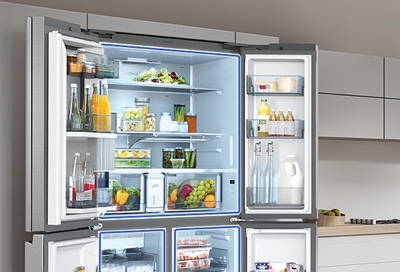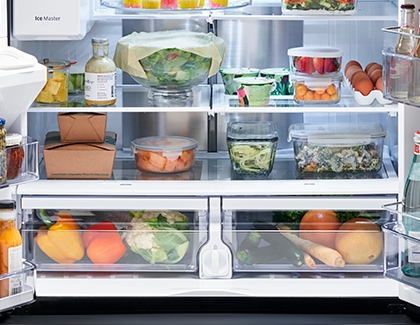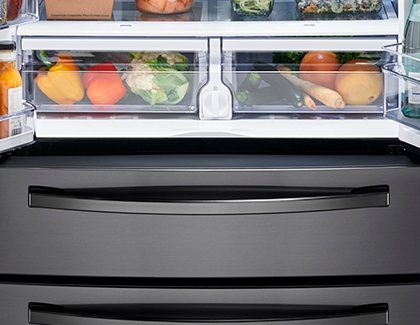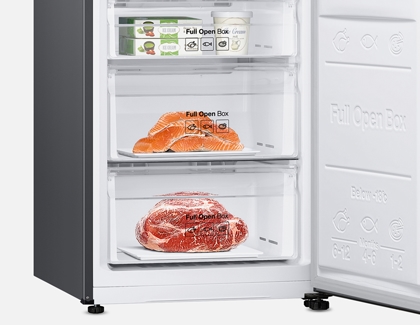Tips for an organized Samsung refrigerator

We know that your fridge plays a critical role in your family's diet. And the larger your family, the more food you will need. You probably don't think about it that much, but where you place food in the fridge can really affect how long the food lasts. Use these tips to organize your fridge and keep your food fresh.
Store items that don't spoil easily in the door bins
Many people like to place items in the fridge door for quick and easy access. But this may not be the best thing for certain types of food.
This is because the refrigerator's door is the warmest part of the fridge. When you open the door, these items are exposed to the warm outside air, which heats them up.
So you should only put items that don’t need to be very cold in the fridge's door bins, such as:

Condiments
Butter
Juice
Cooking oils
Water
Soda
Keep things cool on the upper shelves
The upper shelves are the second warmest part of the fridge. This area can reach up to 40°F, which is the ideal temperature for many foods.
This makes it a good place to keep items that need to be cool but not overly cold. For example, have you ever had yogurt that somehow got frozen over? Storing certain items on the top shelf can prevent this while also keeping your food nice and cold.
Here are examples of food to store on the upper shelves:

Jam and jelly
Cheese
Leftovers
Peanut butter
Yogurt
Snacks
Place dairy and meat on the lower shelves
If you've been following along, you can probably guess what we're going to say next: the lower shelves are the coldest part of the fridge.
This makes it a great place to store items that spoil easily or are more likely to develop bacteria. The cold air naturally helps to preserve the food, so the bacteria won't grow as quickly.
Always store these items near the bottom of the fridge to prevent them from going funky:

Milk
Eggs
Raw fish, meat, and poultry
Crisper drawers help produce last longer
Fruits and veggies have their very own special place in the fridge called crisper drawers. These drawers let you adjust the humidity depending on what kind of items you're storing.
Vegetables like when the humidity is set to high, whereas fruits like it set to low. Usually, there are two crisper drawers available to help separate your produce.
But if you're still a little unsure of what goes where, here's a helpful list:

Mushrooms
Peppers
Summer squash
Apples and grapes
Ripe pears and plums
Ripe avocados, peaches, and melon
Low-humidity drawer
Herbs
Cabbage
Broccoli
Green Onions
Leafy Greens
Cauliflower
High-humidity drawer
Things not to put in the refrigerator
You're probably inclined to put everything in the fridge to help it last longer. However, your fridge can actually affect foods in different ways. For example, honey will crystallize in the fridge and bananas will take longer to ripen.
Here are some items you should NOT place in the fridge:
Bananas
Bread
Coffee
Olive Oil
Onions
Potatoes
Honey
Berries
Other fridge organization tips
Here are some other tips to help organize your fridge and get the most out of your food:
Make sure to keep eggs in their original carton because this helps them last longer.
Keep meats on trays or in sealed bags to prevent drippings from contaminating other foods.
Although it can't go in the fridge, you may store bread in the freezer to help extend its shelf life a few weeks.
You can place a small lazy susan in the fridge to help store and organize containers for easy access.
Large amounts of leftovers should be transferred to several small containers, so they’ll cool faster. You should also position them towards the front of the fridge so you don't forget them.
Some foods can get pretty smelly, but storing them in airtight containers keeps those smells from getting into other foods, the rest of your fridge, or even your kitchen.
If you store leftovers at eye level, you're more likely to notice them and remember to eat them before they go bad!
Make sure you're following the USDA's recommendations for leftovers and food safety.
Tips for an organized freezer
Having an organized freezer is just as important, if not more important, than an organized fridge because the freezer is meant to help food last as long as possible. Follow these tips for a tidy ice box that can fit more food:
Do not store things that need to stay very cold on the freezer’s door since this area gets exposed to warm air frequently. Instead, store items that won’t spoil easily, such as bread, ice packs, butter, flour, or nuts.
Use the top shelf to store items that won’t leak and potentially contaminate your other food items. Things like bread, baked goods, fruits, and vegetables are great for the top shelf. It’s also the best place to store popsicles and ice cream.
The bottom shelf is where you should store items that may leak and contaminate other food. This includes meat, fish, soups, sauces, or prepared meals.

Do not store ice cream near the door where warm air will hit it every time you open the freezer. In addition, put plastic wrap over the opening of the ice cream container before putting on the lid. This seals the container and prevents freezer burn.
The following items should never be stored in the freezer: eggs, cooked pasta, dairy products (excluding ice cream and similar frozen treats), condiments, carbonated drinks like soda, and defrosted meat or fish.
Always label and date food packages you’ve placed in the freezer. This will help you remember when you froze the item and how old it is.
Store food packages (such as boxes or bags) vertically when possible. Most people lay down food items horizontally but having them vertical actually saves a lot of space in the freezer!
Other answers that might help
-
Mobile 8 AM - 12 AM EST 7 days a week
-
Home Electronics & Appliance 8 AM - 12 AM EST 7 days a week
-
IT/Computing 8 AM - 9 PM EST 7 days a week
-
Text Support 24 hours a day 7 Days a Week
Contact Samsung Support



